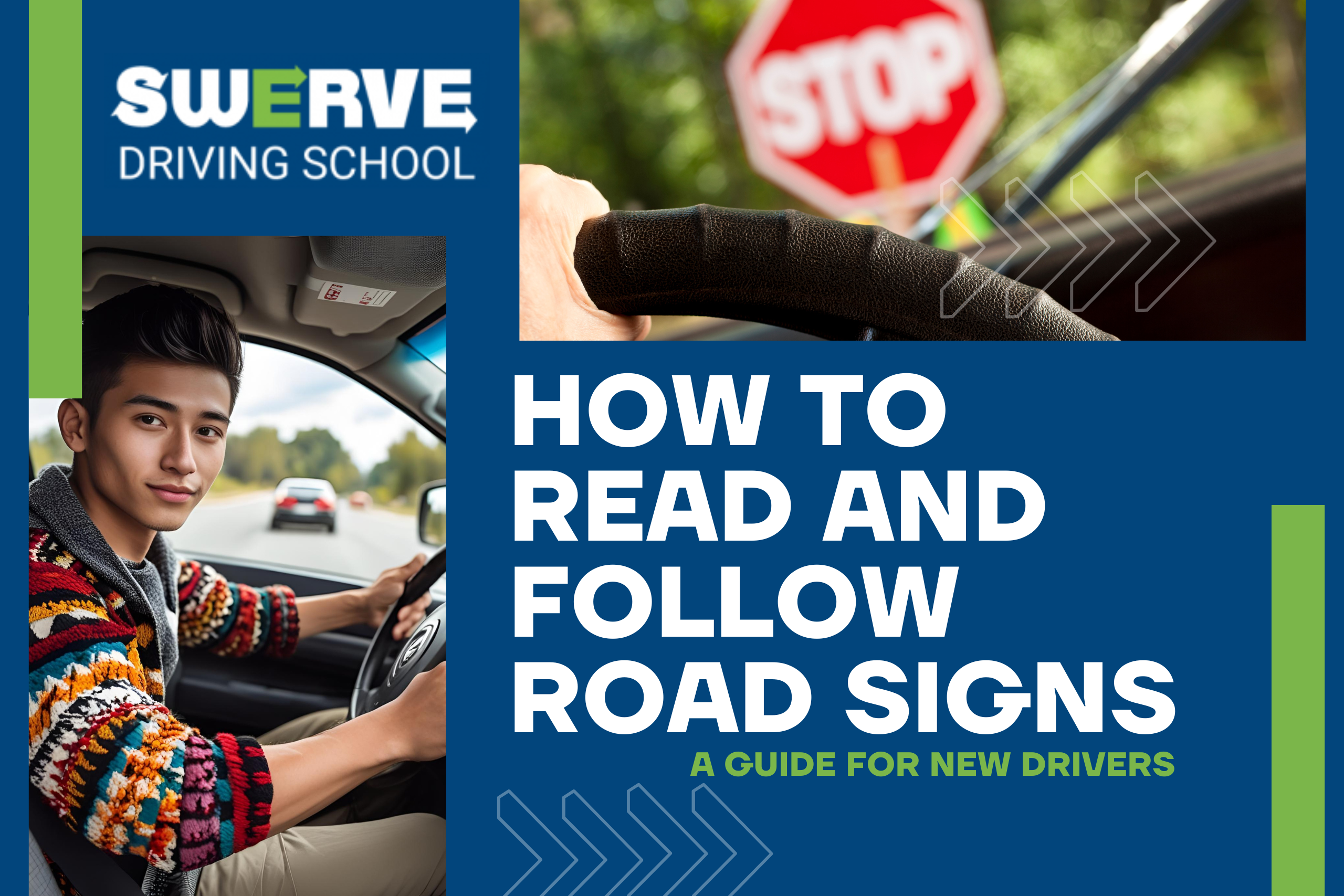
Studying to interpret street indicators is an important talent for brand spanking new drivers. Street indicators talk guidelines, warnings, and useful data that preserve site visitors flowing safely. In america, these indicators are standardized in form and coloration, making them simpler to acknowledge at a look. For instance, the distinctive octagon form of a STOP signal immediately alerts you to organize to cease – even earlier than you possibly can learn the phrase “STOP”. This beginner-friendly information will clarify the important thing varieties of street indicators – regulatory, warning, development, information, and leisure – together with their typical colours, shapes, and meanings. You’ll additionally discover recommendations on deciphering unfamiliar indicators and recognizing indicators by form and coloration. Let’s get began!
Regulatory Indicators (Guidelines of the Street)
Regulatory indicators talk the legal guidelines and guidelines of the street – what you have to do or should not do in that space. These indicators regulate site visitors habits (equivalent to pace limits, instructions of journey, turns, and parking) and have to be obeyed similar to site visitors legal guidelines. Most regulatory indicators are rectangular (vertical or sq.) with a white background and black letters or symbols. Some regulatory indicators use purple components to attract consideration, particularly for prohibitions. For instance, a purple circle with a slash means “No” – as in “No U-Flip” or “No Parking”. Just a few essential regulatory indicators have particular shapes and colours of their very own: the STOP signal is a purple octagon (eight sides), and the YIELD signal is a red-and-white inverted triangle – these are immediately recognizable and distinctive to these instructions.
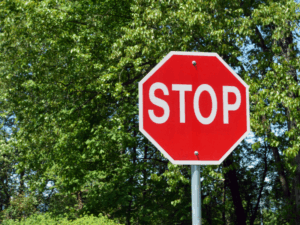
- Cease Signal: Pink octagon with white letters studying “STOP.” It requires a full cease on the restrict line or crosswalk; don’t proceed till secure. Each driver should know this signal on sight!

- Yield Signal: Pink-and-white upside-down triangle. It means decelerate and be able to cease; yield right-of-way to others within the intersection or street you’re coming into.
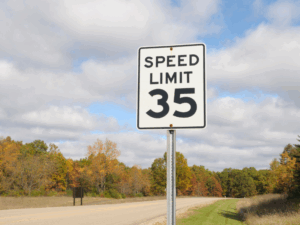
- Pace Restrict Indicators: White vertical rectangles with black numbers/textual content. These point out the utmost (and typically minimal) pace allowed on that stretch of street (e.g. SPEED LIMIT 55).
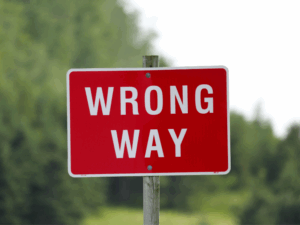
- Do Not Enter / Unsuitable Manner: Pink-and-white indicators indicating you should not enter a street or ramp from the course you’re coming. A DO NOT ENTER signal is often a purple circle with a horizontal white bar, and WRONG WAY is a purple rectangular signal – each warn you in opposition to driving into oncoming site visitors.
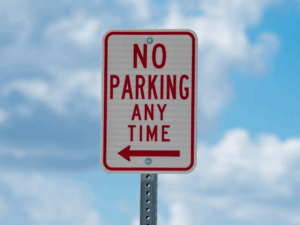
- No Flip/No Parking Indicators: White indicators with purple arrows or symbols or a purple circle-and-slash. These point out prohibited actions (e.g. No Left Flip, No U-Flip, No Parking). The image or arrow in purple slash reveals the place or what will not be allowed.
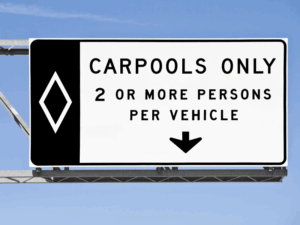
- Regulatory indicators also can embrace lane management indicators (like ONE WAY or LEFT TURN ONLY), HOV lane indicators, truck restrictions, and extra. Take note of all regulatory indicators—ignoring them may imply you’re breaking the legislation. For those who see a white rectangular signal, learn it rigorously, because it possible incorporates an vital rule it’s essential to comply with.
Warning Indicators (Hazards Forward)
Warning indicators are designed to seize your consideration and provide you with a warning to potential hazards or modifications within the street forward. Within the U.S., warning indicators are usually yellow with black symbols or lettering, and most are diamond-shaped. If you see a warning signal, you must decelerate and put together for the situation indicated – these indicators are in your security. Frequent warning indicators embrace alerts for curves, intersections, lane merges, and crossings of pedestrians or animals.
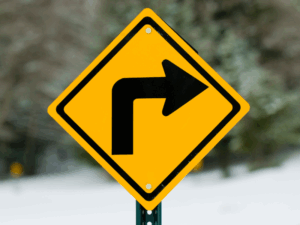
- Curve and Flip Indicators: Yellow diamond indicators with a curved arrow point out a pointy bend or flip forward (e.g. a winding street, sharp left/proper curve, or hairpin flip). Decelerate to a secure pace once you see these. Generally an advisory pace plate is posted beneath the curve signal, suggesting a secure pace for the flip (e.g. “35 MPH”).
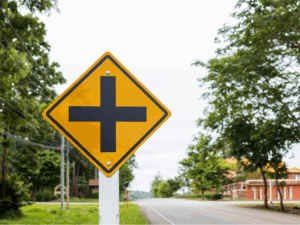
- Intersection Forward: A diamond signal with a “+”, “T”, or “Y” image warns of an upcoming intersection or junction. Be ready for crossing or coming into site visitors. For instance, a “+” image means a crossroads forward, and a “T” means the street you’re on will finish at a T-intersection.
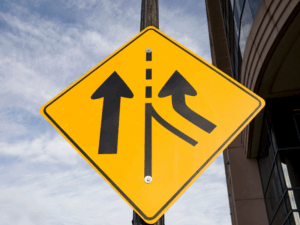
- Merging Visitors: A diamond with an arrow and merging lane image warns that one other street joins in from the facet. As an example, “merge forward from proper” reveals a smaller line merging right into a major arrow. This implies automobiles could also be coming into your lane – be vigilant and permit them to merge safely.
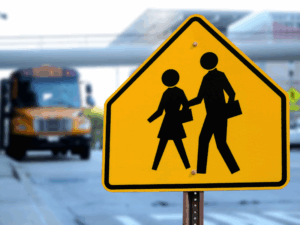
- Pedestrian & College Crossing: A yellow pentagon (5-sided) signal displaying two folks signifies a faculty zone or college crossing space. A diamond with an individual strolling or a pair of pedestrians means a common pedestrian crossing forward. Decelerate and look ahead to folks within the crosswalk. Some college and pedestrian indicators are fluorescent yellow-green for further visibility close to colleges or playgrounds.
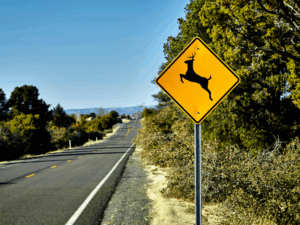
- Animal Crossing: These indicators function a silhouette of an animal (deer, cattle, and so forth.) on a yellow diamond. They warn that wildlife could cross the street in that space. For those who see a deer crossing signal, be further cautious – particularly at daybreak or nightfall – and be able to brake for animals.

Street Situation Warnings: There are lots of others: Slippery When Moist (automobile with skid marks image), Steep Hill (truck on a slope), No Passing Zone (yellow pennant-shaped triangle pointing right-to-left, often on the left facet of the street), Slim Bridge, Lane Ends, Cease Forward/Yield Forward (typically a diamond signal displaying a smaller cease or yield signal image forward), and so forth. Every warns you to regulate your driving.
Keep in mind, shapes and colours are key: nearly all warnings are yellow diamonds, besides just a few particular instances. A spherical yellow signal with a black “RXR” or crossbuck (X) image is an advance railroad crossing warning – that is the one round warning signal. And as talked about, the pentagon form denotes college zones/crossings, whereas a triangular pennant (often yellow) on the left facet of a two-lane street marks a No Passing Zone. Regardless of the form or image, obey all warning indicators and be cautious within the space indicated.
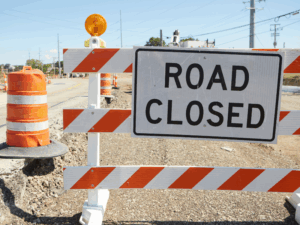
Development (Work Zone) Indicators
Development and upkeep zones have their very own particular signage. These indicators warn you that street work or non permanent site visitors management is forward. Development indicators are orange with black symbols or textual content, typically in the identical diamond or rectangular shapes as different warning indicators. If you see orange indicators, decelerate and keep alert: the street could have staff current, lane shifts, or tools on or close to the roadway.
Frequent work zone indicators embrace “Street Work Forward,” “Development Forward,” “Detour,” “Lane Closed,” or “Flagger Forward.” They may present symbols like a employee with a shovel, a flag individual, or detour arrows. These non permanent indicators are often posted prematurely of the work space to present you loads of warning. If lane closures or detours are in impact, you’ll usually see orange arrow boards or orange-and-white striped barrels/cones guiding you the place to go.
At all times obey the directions on development indicators and any flaggers directing site visitors. It’s not solely about security – it’s additionally the legislation. Speeds could also be diminished in work zones (you may see an “Pace Restrict 25 – Work Zone” signal, for instance). Even when a particular work zone pace isn’t posted, you might be anticipated to drive at a secure diminished pace by the world. Do not forget that fines for violations may be increased in development zones (some states double the fines), and staff could also be simply toes away out of your automobile. Keep targeted, decrease distractions, and be ready for sudden stops or merges close to work zones. Orange indicators imply “decelerate, one thing’s totally different right here!”
Information Indicators (Instructions & Data)
Information indicators enable you to navigate on the street by offering instructions, routes, and different helpful details about your journey. They arrive in just a few coloration schemes, however the commonest information indicators are inexperienced with white lettering. Inexperienced information indicators usually present freeway instructions, exit indicators, metropolis distances, avenue names, and route numbers. If you’re in search of an exit or looking for your method, these inexperienced indicators are your mates.
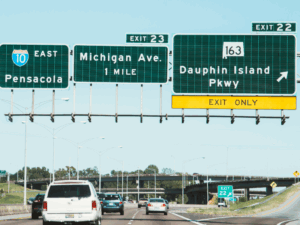
- Freeway and Exit Indicators: These are often massive inexperienced horizontal rectangles mounted overhead or roadside. They present upcoming exits, freeway junctions, or route instructions. For instance, an indication may say Exit 45 – Springfield – 1 Mile or have arrows indicating which lane to take for a selected freeway. The textual content and arrows on the signal information you to your vacation spot or connection.
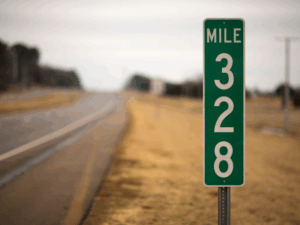
- Route Markers: Highways and interstates typically use distinctive protect shapes for his or her route markers (which might seem on information indicators or standalone indicators). As an example, the Interstate freeway protect is purple, white, and blue; U.S. highways typically use a black-and-white protect; state routes could have their very own shapes (circle, diamond, or state define). These route indicators enable you to affirm you’re on the right street. The colour of route markers varies (notably the Interstate protect contains purple and blue), however they’re often discovered on the inexperienced directional indicators or on their very own indicators at intersections as pictured above.

- Vacation spot and Distance: Inexperienced indicators additionally listing cities, cities, or factors of curiosity with arrows and distances. For instance, after you enter a freeway you may see an indication like Smallville 5 -> | Springfield 27 -> indicating that Smallville is 5 miles in that course, Springfield is 27 miles. This allows you to know you’re headed the fitting method and the way far you’ve left to go.
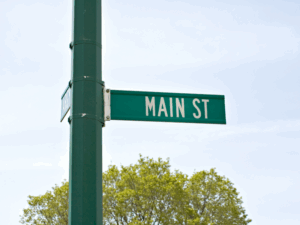
- Road and Exit Indicators: In city areas, huge inexperienced indicators or smaller inexperienced avenue indicators inform you avenue names, freeway exit names or numbers, and which lanes go the place. A inexperienced signal may also mark the doorway to a freeway (e.g. an on-ramp signal for I-90 West).
Information indicators aren’t simply inexperienced, nevertheless. Blue and brown indicators are additionally varieties of information/informational indicators. Blue indicators are for motorist companies: they direct you to companies like fuel stations, eating places, lodging, hospitals, or relaxation areas. For instance, alongside highways you’ll typically see blue indicators with logos or phrases displaying the fuel stations or meals accessible on the subsequent exit. A blue signal with an enormous white “H” directs you to a hospital. Brown indicators, alternatively, are for leisure or cultural curiosity places – we’ll cowl these subsequent intimately. All of those information indicators enable you to discover what you want on the street, whether or not it’s your route, a spot to eat, or a state park to go to.
Leisure Indicators (Parks & Factors of Curiosity)
Leisure and cultural curiosity indicators are simple to identify as a result of they’re the one customary street indicators which can be brown. A brown signal guides you towards parks, historic websites, campgrounds, scenic areas, or different leisure services. They’re typically posted on highways or at exits to level out nationwide parks, state parks, picnic areas, mountain climbing trails, museums, or different points of interest which may curiosity vacationers. The textual content or symbols on the signal will often point out the kind of web site (for instance, a tent image for a campground, a swimmer for a seaside, or an historic marker image).
Brown leisure indicators are informational (like information indicators), so that they’re often rectangular in form with white lettering or symbols, much like different information indicators. As an example, on a street journey you may see a brown signal that claims “Grand Canyon Nationwide Park – Subsequent Exit” or an emblem of a skier with the phrases “Ski Resort 5 Miles.” These let you recognize a leisure space is close by. In cities or cities, brown indicators may level out landmarks (like historic districts or museums).

- Park and Forest Indicators: Indicators directing to nationwide parks, state parks, nationwide forests, or wildlife refuges are brown. They may embrace the identify of the park (e.g. Yellowstone Nationwide Park) and an arrow, or only a image like tree, deer, or picnic desk with distance data.

- Recreation Space Facilities: Brown indicators additionally present services like tenting, boating, mountain climbing, and swimming areas. For instance, a brown signal with a white tent means a campground; one with a fish may mark a fishing space; a skier image for a ski space, and so forth. These symbols are standardized so that you’ll acknowledge them wherever you journey.
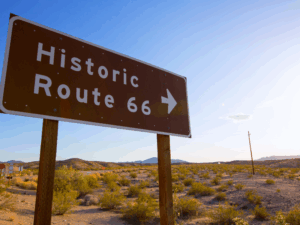
- Historic and Cultural Websites: If a web site is of historic curiosity, a brown signal may level it out. You may see an indication for a Civil Battle battlefield, a well-known monument, or perhaps a historic route. These typically have a descriptive identify on the signal (e.g. “Lincoln Birthplace – 2 mi →”).
Brown indicators have a tendency to look in proximity to the positioning – for instance, on the freeway exit or alongside the native roads resulting in the attraction. They’re there to information vacationers to leisure or cultural locations with out getting them confused with extra crucial site visitors directions. So, whereas a brown signal may not be telling you how one can drive, it’s providing you with helpful information in the event you’re in search of enjoyable or fascinating stops. Preserve a watch out for these once you need to discover; they will make street journeys extra pleasant by highlighting locations value visiting!
Suggestions for Recognizing Indicators by Form and Coloration
By now you’ve observed a theme: the colour and form of an indication offer you huge clues about its that means earlier than you even learn it. As a brand new driver, it’s sensible to memorize the fundamental signal shapes and colours used within the U.S. so you possibly can react shortly and appropriately. Listed below are some key ideas and examples:
- Octagon = STOP: Solely cease indicators use an octagonal form (8 sides). Even when lighting or distance makes the phrase onerous to learn, an octagon form (particularly in purple) at all times means “STOP.” Begin slowing down once you see it, and put together to cease fully on the line.
- Triangle = YIELD: An equilateral triangle pointing downward is completely for yield indicators. For those who spot a red-edged triangle form, know that you just’ll must decelerate and yield to cross site visitors or pedestrians.
- Circle = Railroad Crossing: A spherical (round) signal is used just for an advance railroad crossing warning. It is going to be yellow with a black “RR” or X image. Properly earlier than you attain the tracks, look, pay attention, and be able to cease if wanted. (On the crossing itself, you’ll see a crossbuck signal – an X form – and probably flashing lights or gates.)
- Diamond = Warning: Diamond-shaped indicators (often yellow or orange) imply warning – there’s some hazard or change forward. For those who see a diamond, even from afar, think “what ought to I be prepared for?” It could possibly be something from a pointy curve to a deer crossing. Decelerate and scan the street.
- Pentagon = College Zone: A five-sided signal (formed like a home) signifies a faculty zone or college crossing. Usually, it’s yellow or fluorescent green-yellow and reveals two pedestrians. If you acknowledge this form, be extraordinarily watchful for youngsters and obey any diminished college pace zone.
- Pennant = No Passing Zone: A sideways triangle (pointing to the fitting, often on the left facet of the street) is a No Passing Zone signal. For those who glimpse this uncommon form, it means don’t overtake different automobiles on this stretch of street. It’s there due to restricted sight distance forward (hills, curves).
- Rectangles (Vertical or Horizontal): Vertical rectangles are typically regulatory (e.g. pace limits, NO PARKING). Horizontal rectangles are often information indicators, offering instructions or data. If you see a white vertical rectangle, count on some rule or legislation on it. For those who see an extended horizontal rectangle in inexperienced or blue, it’s possible providing you with route information or a facility location. Road identify indicators are sometimes horizontal rectangles as properly (generally inexperienced).
Colours to Memorize
- Pink at all times alerts a direct motion required or prohibition (cease, yield, don’t enter, mistaken method).
- Yellow means common warning – be alert, circumstances are altering.
- Orange means development or non permanent hazard – decelerate, be ready for staff or detours.
- Inexperienced means directional steering – the place you possibly can go, distances, exits.
- Blue means companies or facilities close by (meals, fuel, hospital, and so forth.).
- Brown means leisure or cultural web site close by.
- Black/White (typically used collectively) are regulatory – pace limits, lane controls, and so forth., often conveying legal guidelines or laws.
When unsure, decelerate and keep cautious. For those who encounter an indication you don’t instantly acknowledge, use the context of its coloration/form to information you. For instance, in the event you see a yellow signal with an unfamiliar image, you recognize it’s a warning – so cut back your pace and be looking out for something uncommon on the street. Many warning indicators use intuitive symbols (like a truck on a hill for a steep grade, or a divided freeway graphic for a median beginning or ending) to convey their message. Attempt to interpret the image within the context of the street you’re on. And keep in mind, typically extra plaques or textual content accompany an indication to make clear its that means (e.g. a “Subsequent 5 miles” plaque underneath a winding street signal means the street will likely be winding for the following 5 miles).
Lastly, research and apply. Your state’s driver handbook or DMV web site can have illustrations of all of the frequent indicators. It’s value reviewing these earlier than your driving check and protecting the information recent. (For instance, the New York DMV’s on-line information gives a useful listing of *“Street Indicators You Should Know” with pictures.) The Federal Freeway Administration additionally publishes the official Handbook on Uniform Visitors Management Units (MUTCD) with customary U.S. street indicators – an important reference if you’d like each element. You don’t must memorize each obscure signal without delay, however begin with the fundamentals coated on this information. Over time and with expertise, you’ll encounter extra indicators and be taught them.
Take note of street indicators’ colours and shapes as a lot as their symbols or phrases. With slightly apply, you’ll instinctively know an indication’s that means from a distance – whether or not it’s telling you to cease, warning you of a hazard, guiding you to your exit, or pointing you towards the closest relaxation space. Secure driving! And preserve these eyes on the street (and on the indicators).
Look to your state’s official driving handbook and DMV/transportation web sites for full lists of street indicators and their meanings. They supply visible examples and explanations for every signal class. Turning into accustomed to these assets will enhance your confidence in studying and following any street signal you encounter. Good luck and blissful driving!


